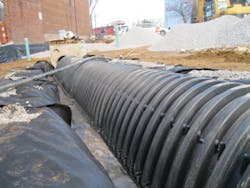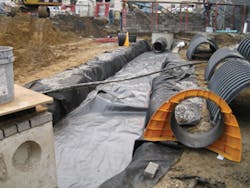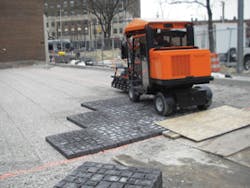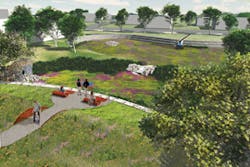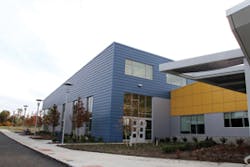Cleveland is in the same boat as many other cities these days. Its aging infrastructure and increased development with impervious surfaces have resulted in waves of combined sewer overflows (CSOs) that have sent polluted water and sewage into nearby waters.
Now Cleveland’s sewer district, Northeast Ohio Regional Sewer District (NEORSD), like that of many other cities, is rowing against the tide of a consent decree from EPA. However, Cleveland and NEORSD have some highly efficient oars they plan to use. If applied effectively, these strategies will result in much cleaner waters and will demonstrate to other cities some innovative and cost-effective stormwater management. But there’s a long way to row before the final shore is safely reached.
The settlement between EPA and the US Justice Department and NEORSD for the district’s violations of the Clean Water Act (CWA) was announced on December 22, 2010, and signed in 2011.
NEORSD serves Cleveland and 61 adjoining member communities. Its coverage area is about 350 square miles. “Only about 25% of that is combined sanitary and storm sewers,” says Kyle Dreyfuss-Wells, manager of watershed programs for NEORSD.
The agency was cited for CSOs of almost 5 billion gallons of untreated sewage that occurred about 3,000 to 4,000 times each year. These CSOs came from 126 permitted outfalls. The CSOs flowed into the Cuyahoga River and Euclid Creek and other tributaries that lead to Lake Erie. The overflows violated water quality standards of NEORSD’s National Pollutant Discharge Elimination System (NPDES) permits, Sections 301 and 402 of the CWA, and EPA operational controls known as the “Nine Minimum Controls.”
Installation work at the University Circle Marriott
EPA’s decree to NEORSD is simple: capture and treat more than 98% of the runoff that enters the combined sewer system. That means reducing more than 4.5 billion gallons of CSOs to 494 million gallons annually.
“For a 20- or 25-year agreement, the usual expectation would be 85 or 90% reduction,” says Bob Newport, stormwater specialist with the EPA’s Region 5. “Here it’s higher because so many CSOs are close to beach along Lake Erie.”
Newport adds, “If there’s a drinking water intake or swimming beach [nearby] the percentage of control [of CSOs] goes up.”
The hard part, of course, is implementing that agreement, but the sewer district will have until 2035 to complete the work that will accomplish this goal.
In addition, NEORSD must pay a civil penalty of $1.2 million. Of this amount $600,000 goes to the federal government and $600,000 to the state of Ohio, which was also a plaintiff in the lawsuit.
Another provision in the consent decree requires NEORSD to pay for a supplemental environmental project (SEP). In this case the SEP is $1 million to establish and operate a permanent hazardous household waste dropoff center for Cuyahoga County residents to use. NEORSD conservatively estimates that this center will take in one million pounds of hazardous waste annually. The facility will accept motor oils and fluids, pesticides, paints, household cleaners, mercury, batteries, and other hazardous materials.
“There are lots of different kinds of SEPs, but you do something to make the water cleaner,” says Newport. “If people don’t have a collection place, they might dump paint or oil into the drains of the sewer system.”
Newport refers to the example of another SEP that was required in Fort Wayne, IN. “There were houses on small lots with failing septic systems. They had never been connected to the sewer system. One of their SEPs was to connect those houses to the sewer system,” he notes.
NEORSD has named its monumental task Project Clean Lake. It is expected to cost $3 billion. When it is complete, total suspended solids (TSS) will be reduced by more than 15.3 million pounds per year, total nitrogen by more than 370,000 pounds per year, and biological oxygen demand (BOD) by more than 4.7 million pounds per year.
Besides cleaner water in Lake Erie and elsewhere, another benefit of Project Clean Lake is economic. Cleveland State University’s economic impact study estimated that the project will generate 31,000 jobs, $3 billion in labor income, and $443 million in tax revenue. For every dollar invested, the estimated return is $2.63. Paying for Project Clean Lake will require rate increases for residents. The increases will likely be double digits for the first few years, but NEORSD is developing some rate-saving programs.
The Green and the Grey
The goals of Project Clean Lake will be accomplished through a combination of grey and green infrastructure.
“Our constituents really like that we’re looking at a combination of grey and green,” says Dreyfuss-Wells. “Utilities need to explore green infrastructure more.” She concedes, though, that “Green is still harder to do. If you want grey, you can get it done.”
Grey infrastructure is a big component of Project Clean Lake, Dreyfuss-Wells says, because it “is so efficient at managing large volumes of water.”
“That we have to capture so much stormwater has been one of the big issues,” says Vicky McCauley, stormwater design manager for engineering and
construction at NEORSD. “There are different ratios for each sewershed, ranging from five to 12 gallons of stormwater infiltrated to control one gallon of CSO.”
In the grey infrastructure category, the decree mandates the installation of seven big tunnels to hold polluted runoff to prevent it from flowing into major tributaries. The tunnels will hold 75 million gallons of combined stormwater and sewage as it waits for treatment. They range from 2 to 5 miles in length and are up to 24 feet in diameter. One of these, the Mill Creek tunnel, is finished. The Euclid Creek tunnel is under construction and will be finished in 2015. The remaining five will be constructed in the years following.
The new grey infrastructure will also include expansion at the existing Easterly and Southerly wastewater treatment plants and at the CSO facility adjacent to the Westerly plant. NEORSD will upgrade several pump stations, regulators, and other parts of its system.
The consent decree requires NEORSD to install enough green infrastructure to capture 44 million gallons of CSO discharge in a typical year. To accomplish this goal, the sewer district has agreed to invest at least $42 million in green infrastructure.
If the $42 million dollars’ worth of green infrastructure removes more than 44 million gallons of CSO, NEORSD can request an equal reduction in its required grey infrastructure. It can also ask to add more green infrastructure in exchange for reductions of the grey.
Newport says that although EPA has mandated the amount of CSO reduction Cleveland must achieve using green infrastructure, “once the performance standard is set, the sewer district has the latitude to make choices [of projects to achieve it].”
“Mandatory Green”
Cleveland has eight years to implement its green infrastructure related to CSO reduction, i.e., its “mandatory green.” EPA has set another two years beyond the eight for the sewer district to make adjustments as needed to meet the requirements of the decree.
One of the first stormwater projects to count toward what NEORSD officials call their “mandatory green” amount (as opposed to other green infrastructure projects that aren’t near CSO locations) is at the new Courtyard at Marriott hotel. Opened in April 2013, the new hotel is in University Circle. This area is known locally as “eds and meds” because Case Western Reserve University, the Cleveland Clinic, Symphony Hall, and other educational, medical, and cultural facilities are clustered there.
Collinwood Recreation Center on Lakeshore Boulevard
The hotel’s 1-acre site will infiltrate 100% of its stormwater, up to a 100-year rain event. The area’s sandy soil, a rain garden, and a parking lot of all pervious pavers help make this possible.
Water from the roof is collected and held in an underground detention chamber long enough to soak into the ground. Runoff is kept out of the Doan Brook watershed, one of Cleveland’s worst CSO sites.
“The University Circle Marriott is a great example of a partnership,” says Dreyfuss-Wells. “We’re always looking for great opportunities to partner with businesses and community organizations.”
She explains that the sewer district funded the differential cost between regular grey infrastructure and the green infrastructure installed at the Marriott. “We’re paying the delta,” she says.
Another stormwater project that falls within the mandatory green infrastructure part of the consent decree is at the Urban Agriculture Innovation Zone. This 23-acre site at Kinsman and East 81st Streets has been set aside for small farmers to grow vegetables, fish, and other foods.
“That project hits all the buttons,” explains Dreyfuss-Wells. “It’s in a neglected neighborhood with a legacy of being underserved. It’s 80% vacant.”
Still, there is a lot of interest in revitalizing the area through this project that will bring jobs. Ohio State University Extension and various community groups are supporting the three boyhood friends who grew up there and are now the first of the urban farmers.
Fleet Avenue
“It will be designed by the end of 2013 and constructed in 2014,” says McCauley. “The ratio there is high. We have to capture almost 12 million gallons of stormwater to equate to a CSO capture of two million gallons.”
To help accomplish that goal, McCauley says, “Along the main street there will be a bioswale to capture runoff. Most of the flow will be routed to bioretention basins to treat the runoff and discharge it to the storm sewer outlets.”
Dreyfuss-Wells adds, “The sewer system can come in and build an infrastructure spine, sewer service, and landscape amenities.”
Slavic Village, on the east side of Cleveland, will have several demonstration projects that are included in the mandatory green category. Fleet Avenue, a streetscape collaboration with the city of Cleveland, will have bioretention cells and basins and curb bumpouts with infiltration wells.
One of the projects is located in a vacant lot along Union Avenue, which will have rain gardens. Using vacant lots as green infrastructure to infiltrate stormwater is breaking new ground here. Turning a bare eyesore into a park for the neighborhood brings a benefit beyond reducing runoff.
To learn more about this infiltration strategy, NEORSD has been working with Bill Shuster, a research hydrologist and soil specialist with EPA. Shuster spent two and a half weeks in Cleveland, collecting soil samples from parks and vacant lots in 42 sites. He analyzed the soil samples, taken from the far eastern side of Cleveland to the far western side, to learn about the sites’ hydrology. He wanted to find out if they offer opportunities to store and infiltrate urban runoff.
Shuster discovered that Cleveland has an asset: sandy soils derived from “bands of ancient sand dunes that go deep. They’re highly infiltrative.”
That said, measuring the infiltration rates of the different soils revealed variety. Shuster notes that soils in some areas, for example, might be better suited for a wetland than for a rain garden.
Using vacant lots for stormwater infiltration is “leveraging land that’s been abandoned in urban core areas,” explains Shuster. “These areas are hot spots of vacancies, with lots of abandoned buildings.”
Turning vacant lots into mini parks provides “an opportunity to restructure our urban areas on the lines of more natural land,” he adds.
Urban vacant land is far from its natural state that nourishes plants. Even if it isn’t an industrial brownfield, it might contain debris from demolition, residue from lead paint and hazardous substances, and other impediments to plants. The soil is likely compacted from bearing the weight of buildings and equipment.
Vacant urban land has another drawback. When cities were built in the Midwest in the 1920s, stormwater was managed by making it flow away from buildings, down driveways to streets. Yards, especially front ones, were sloped to encourage runoff.
If plants are to grow on abandoned vacant lots, the soil must be enriched and loosened. Debris and contaminants must be cleared, and lots will probably have to be regraded so that runoff won’t flow away before it has a chance to infiltrate onsite.
Of course, green infrastructure is not new to Cleveland and other communities served by NEORSD. “We have $250,000 available for small-scale stormwater projects—not part of “˜mandatory green.’ We’ve done this every year since 2009,” says Dreyfuss-Wells.
Another older green infrastructure project is Village 115, a LEED-certified dorm by the football stadium at Case Western Reserve University. Completed in 2005, the project has a large cistern under the stadium to hold runoff until it can soak into the sandy soil. “It’s a given that their projects will have top-of-the-line stormwater measures,” says Dreyfuss-Wells.
Exterior of the Watershed Stewardship Center
The Collinwood Recreation Center on Lakeshore Boulevard is an $11 million project that turned an abandoned big-box store into a community asset. A bioretention pond, an 1,800-gallon cistern, and sand beds let all of the site’s stormwater and some runoff from Lakeshore Boulevard infiltrate on the property. Surrounded by empty parking lots and buildings, Collinwood is a green island in a sea of pavement and concrete. Dreyfuss-Wells says what she loves about the site is seeing the contrast of old and new.
Public Education
Just as NEORSD customers are getting used to the idea that they will be paying higher rates from now on and realizing the magnitude of the CSO problem, they have a new stormwater asset available to help the entire community. This model for public education is the new Watershed Stewardship Center.
Opened in late spring of this year, the new center is located within West Creek Reservation. This 324-acre site is part of Cleveland Metroparks in a valley with residential neighborhoods on surrounding hills.
“We partnered with NEORSD to put together this Watershed Stewardship Center,” says Richard Kerber, director of planning, design, and natural resources for Cleveland Metroparks, who is well aware of the convergence of water issues. “There is certainly a lot of discussion. People are talking and thinking about water issues—algae blooms, fracking, and shale drilling [about 70 miles away], the consent decree.”
The Watershed Stewardship Center began when a group of citizens got the city of Parma to set aside almost 200 acres for a park. Part of the site had been the old municipal landfill. Metroparks then leased the property from the citizens group added facilities and trails.
Exhibits planned for the Watershed Stewardship Center
“We have six other visitors and nature centers at our parks. This is the first one designed as a learning and gathering center. It was designed to be a focal point for groups dealing with water issues,” says Kerber.
He adds, “It’s a physical manifestation of ideas and a place to come and hold trainings and meetings.”
Although Kerber and other Metroparks staffers have looked at other places around the country, “We couldn’t find anything exactly like this. We have three stressors on our parks: deer, invasive species, and the quality of our streams.”
And while staffers are working on controlling the deer and invasive species, “It’s a cliché, but it takes a village to improve the water. We wanted this to be the stormwater clubhouse,” he says.
“We’ll train people to go into their neighborhoods [to discuss water concerns with their neighbors]. In addition to getting more acceptance, they’ll give us multiple eyes and ears to let us know if something there needs to be protected or there is a problem,” explains Kerber.
“We have our normal staff available to greet people, and we have an outdoor education division. They handle specialty programs, such as birding,” he says.
Outdoor training facilities include an area just behind the center where volunteers will be shown how to do planting and other aspects of stream restoration. Once trained, they will move out into West Creek Reservation to use their new knowledge. Volunteers who acquire enough expertise can become Certified Watershed Specialists. These citizen scientists can eventually design their own projects to work on and can make a difference back in their neighborhoods.
Indoors, there are meeting rooms for community organizations, such as watershed support groups. There are also offices and labs for stormwater and environmental professionals.
“We did create a working environment for about 20 staff people—people from the sewer district, from our natural resources division, from other agencies. We’re literally housing them here for their jobs.”
Having these people onsite or at least working out of the Watershed Stewardship Center offers two major advantages. These exerts are conveniently available to teach classes to volunteers and help with events for the public. They also have more opportunities to network and collaborate with each other.
Kerber believes that the Watershed Stewardship Center will do much to get local residents involved with water issues. “The average person feels so disconnected, thinking “˜What can I do on my one-quarter-acre suburban lot?’ But there are ways to get people to do things on their own property.”
And when Cleveland residents visit the center and learn about protecting their watersheds, he thinks they’ll realize “there really are things the average person can do that make a difference.”
Noting how stormwater affects adjoining properties, Kerber says, “Even though we have large holdings–some of our reservations are as large as 4,000 acres–without help from surrounding properties it’s difficult to maintain quality in our parks.”
There’s no doubt that complying with the consent decree is a big project for all involved. “It’s pressure and it’s got us moving,” says Dreyfuss-Wells.
Asked what advice she would have for other stormwater officials who will be working to meet consent decrees, she suggests getting everyone involved in thinking about possibilities for green infrastructure—even the most ardent supporters of grey.
“The folks with the system will identify the real opportunities for green. They have to be in on it from the beginning. They’ll know where green will support the grey,” she says.
“The modeling of green infrastructure is still an emerging science,” Newport cautions. “It’s part hydrology and part hydraulics, “‘h and h’ we call it.” He adds, “Once you set that [green] model up, keep tweaking and adjusting it.”
In the next few years, NEORSD’s engineers, landscape architects, and other employees will be busy designing and constructing green and grey infrastructure. As they monitor results and refine projects, Cleveland citizens educated by the Watershed Stewardship Center will be watching for good results and doing what they can to help.
Stormwater officials within EPA and in many other cities will be watching, too. If all goes well, many of them will want to jump ship from old ways of stormwater management and row in Cleveland’s boat.